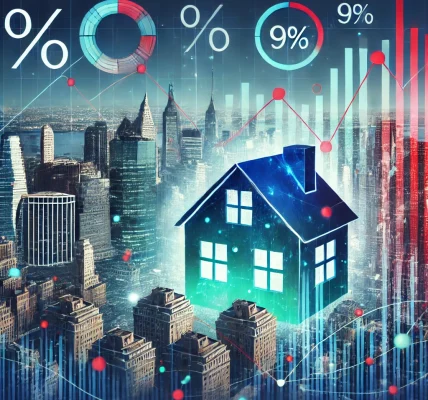Introduction
The real estate industry is undergoing a technological revolution with the rise of smart homes. As consumers increasingly seek convenience, security, and energy efficiency, smart homes have become an attractive option for homebuyers and renters alike. For real estate investors, tech-enabled properties present a lucrative opportunity with strong appreciation potential and enhanced rental income.
This guide explores the future of smart home investments, their benefits, challenges, and how investors can strategically enter this growing market.
What Are Smart Homes?
A smart home is a residence equipped with IoT (Internet of Things) devices, allowing homeowners or tenants to control various functions remotely via a smartphone or voice assistant. These technologies enhance security, energy efficiency, and convenience.
Common Smart Home Features:
- Smart Security Systems: Cameras, smart locks, motion detectors, and alarm systems.
- Automated Lighting & Climate Control: Smart thermostats, smart bulbs, and automated blinds.
- Energy Efficiency Solutions: Solar panels, energy monitoring systems, and AI-driven energy optimization.
- Smart Appliances: Wi-Fi-enabled refrigerators, ovens, and washing machines.
- Voice-Controlled Assistants: Google Home, Amazon Alexa, and Apple HomeKit for seamless automation.
- Remote Access & Control: Homeowners can monitor and control home functions from anywhere.
Why Invest in Smart Homes?
1. Higher Property Value
Smart home features increase a property’s appeal and resale value. Buyers are willing to pay a premium for homes equipped with smart technology that enhances security, comfort, and efficiency.
2. Attracting High-Quality Tenants
Tech-savvy tenants, particularly millennials and remote workers, prefer rental properties with smart features. Offering tech-enabled properties reduces vacancy rates and ensures steady rental income.
3. Energy Efficiency and Cost Savings
Smart homes optimize energy usage, reducing electricity bills. Investors can market energy-efficient properties as sustainable and cost-effective, attracting environmentally conscious buyers and renters.
4. Enhanced Security for Tenants and Owners
Security is a key concern for tenants and property owners. Smart security systems provide real-time monitoring, remote access, and instant alerts, making the property more secure and desirable.
5. Future-Proof Investment
As technology advances, smart home features will become standard rather than optional. Investing in tech-enabled properties today ensures long-term profitability and future appreciation.
How to Invest in Smart Homes
Step 1: Research the Market
Identify high-demand areas where smart home technology is appreciated. Urban locations, tech hubs, and eco-conscious communities are ideal markets for smart home investments.
Step 2: Choose the Right Smart Home Features
Not all smart home upgrades yield equal returns. Prioritize high-value features such as:
- Security Systems: Smart locks and surveillance cameras.
- Energy-Efficient Technology: Smart thermostats and LED lighting.
- Automation & AI Integration: Voice-activated assistants and smart hubs.
Step 3: Select the Right Property
Invest in properties that can be easily upgraded with smart technology. New constructions often come with built-in smart features, while older properties may require renovations.
Step 4: Budget for Upgrades
Determine your budget for smart home upgrades. Essential features like smart locks, thermostats, and security systems are cost-effective and deliver high ROI.
Step 5: Work with Tech-Savvy Property Managers
If you plan to rent out your smart home, ensure your property manager understands smart home technology. They should be able to assist tenants with troubleshooting and maintenance.
Step 6: Market Your Smart Home Investment
Highlight smart home features in property listings. Use phrases like:
- “Energy-efficient smart home with modern automation.”
- “Secure and tech-enabled rental with remote access control.”
- “Future-ready smart home with voice-activated controls.”
Challenges and Risks of Investing in Smart Homes
1. High Initial Investment Costs
Upgrading a property with smart home technology requires upfront capital. However, these costs can be offset by higher rental yields and appreciation.
2. Technological Obsolescence
Technology evolves rapidly. Investors should choose scalable and upgradable smart home systems to avoid obsolescence.
3. Privacy and Security Concerns
Tenants and buyers may have concerns about data privacy and cybersecurity. Ensure the smart home system complies with data protection regulations and allows users to control privacy settings.
4. Compatibility Issues
Not all smart home devices are compatible with each other. Investors should opt for widely used platforms like Google Home, Amazon Alexa, or Apple HomeKit to ensure seamless integration.
5. Maintenance and Technical Support
Some smart home devices require regular updates and maintenance. Having a plan for troubleshooting and repairs is essential to keep the property attractive to tenants.
Final Thoughts: Is Investing in Smart Homes Worth It?
Smart home investments offer promising opportunities for real estate investors looking to increase property value, attract quality tenants, and future-proof their portfolio. As technology adoption grows, tech-enabled properties will become increasingly desirable, providing long-term profitability.




